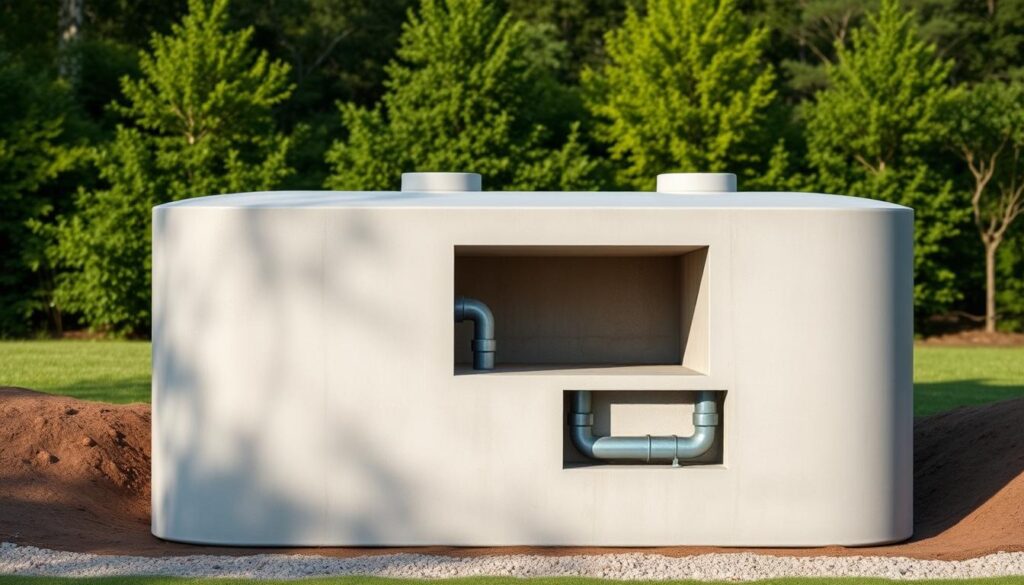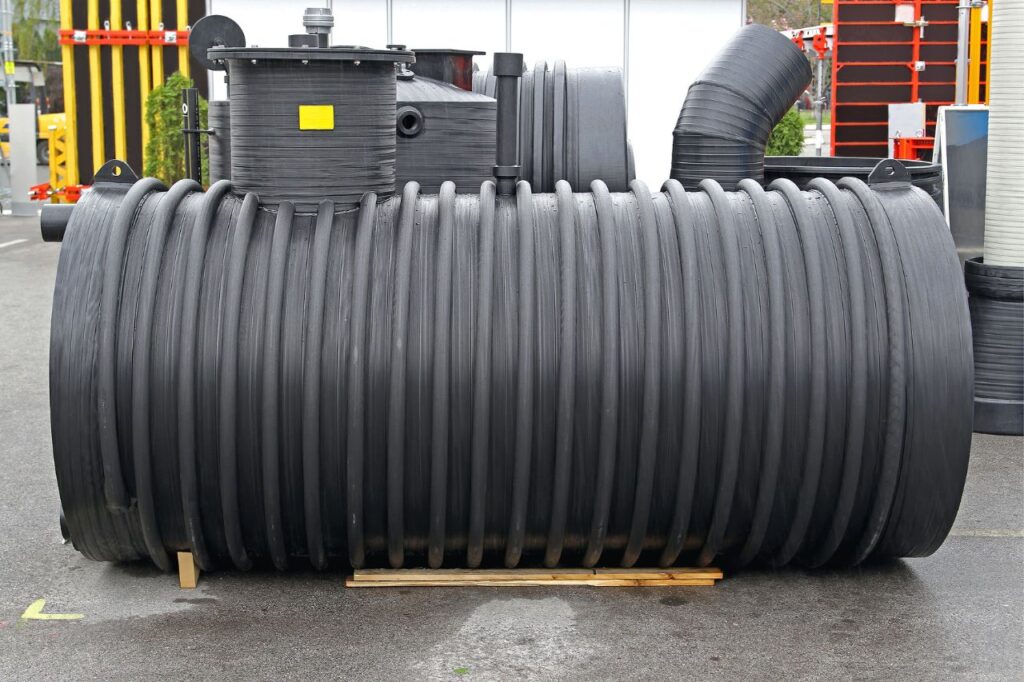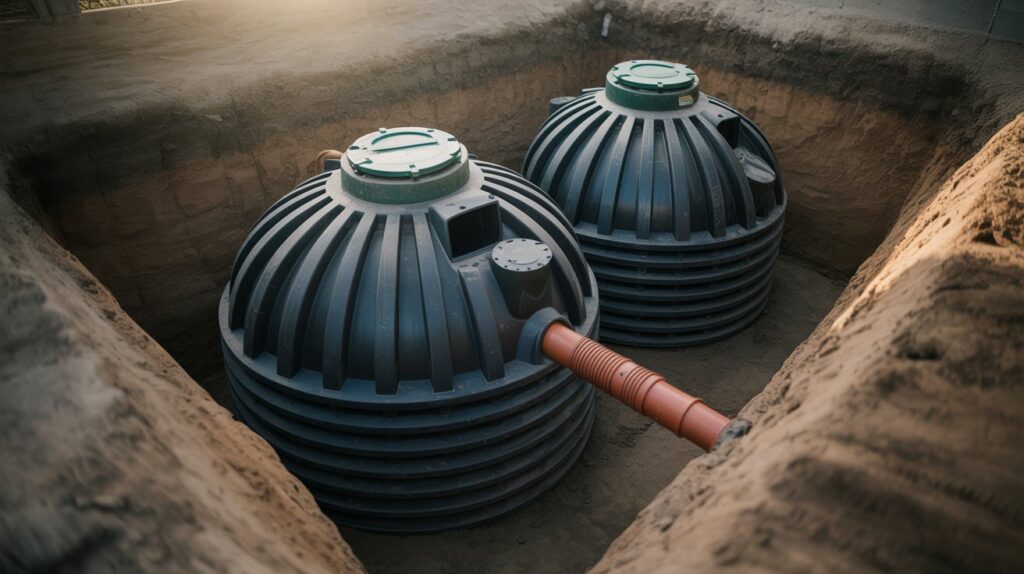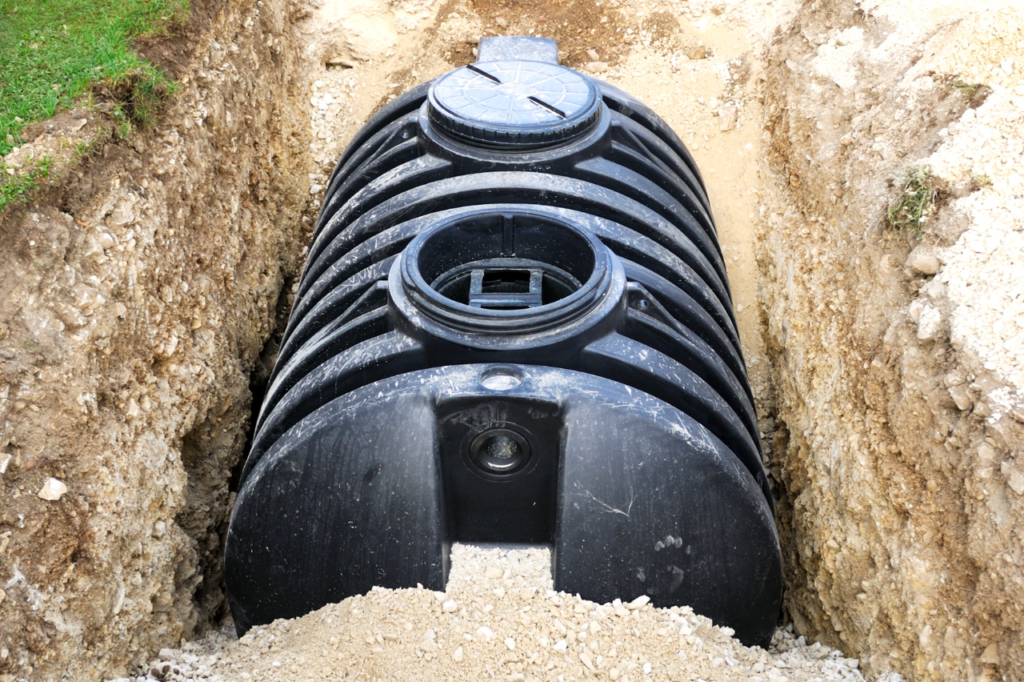Are you unsure whether a single or dual compartment septic tank is best for your property? Selecting the right septic system is crucial for effective wastewater management and environmental protection.
Understanding the differences between single and dual compartment septic tanks can help you make an informed decision that meets your household’s specific needs.

A key consideration is the level of wastewater treatment required for your property. Both single and dual compartment tanks have their merits, and evaluating these options will ensure you choose the most suitable septic system.
Key Takeaways
- Understand the differences between single and dual compartment septic tanks.
- Evaluate your household’s specific wastewater treatment needs.
- Consider the benefits and drawbacks of each septic tank option.
- Make an informed decision based on your property’s requirements.
- Ensure effective wastewater management and environmental protection.
The Fundamentals of Septic Systems
Understanding the fundamentals of septic systems is crucial for homeowners to make informed decisions about their wastewater management. Septic tanks are an essential part of a property’s wastewater treatment process, collecting and treating all the wastewater from a home before it is discharged into the drain field.
How Septic Tanks Process Household Waste
Septic tanks process household waste through a combination of physical and biological processes. Wastewater enters the tank, where solids settle to the bottom and are broken down by bacteria. The treated wastewater then flows out into the drain field for further treatment and dispersal.
The Purpose of Compartmentalization in Waste Treatment
Compartmentalization in septic tanks enhances waste treatment by providing additional stages for wastewater processing. Dual compartment tanks, for instance, offer a secondary treatment phase, improving overall treatment efficiency and reducing the risk of contamination.
Key Components of a Functional Septic System
A functional septic system consists of several key components, including the septic tank, drain field, and inlet and outlet pipes. Regular maintenance of these components is vital to ensure the system operates effectively and safely.
Single Compartment Septic Tanks: Design and Function
Understanding the functionality of single compartment septic tanks is crucial for homeowners considering septic system installation. These tanks are designed to treat wastewater from households by separating it into solid and liquid components.
Structural Components and Materials
Single compartment septic tanks are typically made from concrete, fiberglass, or plastic. The tank’s structure includes an inlet for wastewater to enter, an outlet for treated effluent to exit, and often a manhole cover for maintenance access.
The Waste Treatment Process in Single Tanks
The waste treatment process in single compartment septic tanks involves anaerobic digestion. Bacteria break down the solid waste, reducing its volume and treating the wastewater. The liquid effluent then flows out into the drain field for further treatment.
Typical Applications and Suitable Properties
Single compartment septic tanks are suitable for small to medium-sized residential properties. They are often used in areas where connection to a municipal sewer system is not available.
| Property Size | Tank Capacity | Suitability |
|---|---|---|
| Small | Up to 750 gallons | High |
| Medium | 750-1000 gallons | Moderate |
| Large | Over 1000 gallons | Low |
Regular septic tank maintenance is essential to ensure the longevity and effectiveness of single compartment septic tanks. This includes periodic inspections and pumping of the tank.
Dual Compartment Septic Tanks: Design and Function
The design of dual compartment septic tanks offers several advantages over traditional single compartment systems. By incorporating two chambers, these tanks provide an additional level of treatment, enhancing the overall efficiency of wastewater processing.
The Two-Chamber Configuration Explained
A dual compartment septic tank is essentially divided into two separate chambers. The first chamber allows solid waste to settle at the bottom, while the liquid effluent flows into the second chamber. This separation is crucial for the effective treatment of wastewater.
How Waste Moves Through Dual Compartment Systems
In a dual compartment system, waste moves from the first chamber to the second through a connecting pipe or baffle. This design ensures that the wastewater undergoes a more thorough treatment process, as the second chamber can be designed to provide additional treatment mechanisms, such as filtration or aeration.
Enhanced Treatment Capabilities
The dual compartment design enhances treatment capabilities by providing a longer retention time for wastewater and allowing for more effective separation of solids and liquids. This results in a higher quality effluent being discharged into the drainfield.
| Feature | Single Compartment | Dual Compartment |
|---|---|---|
| Treatment Chambers | 1 | 2 |
| Waste Retention Time | Shorter | Longer |
| Effluent Quality | Lower | Higher |
By understanding the design and function of dual compartment septic tanks, homeowners can better appreciate the benefits these systems offer in terms of improved wastewater treatment and environmental protection.
Choosing the Right Septic Tank: Single vs. Dual Compartment
Understanding the differences between single and dual compartment septic tanks is essential for making an informed decision.
Side-by-Side Performance Comparison
When comparing single and dual compartment septic tanks, several performance metrics come into play. The primary difference lies in their ability to treat wastewater effectively.
Single Compartment Tanks: These tanks are simpler in design and function. They treat wastewater in a single chamber, where solids settle and are broken down by bacteria.
Dual Compartment Tanks: Dual compartment tanks, on the other hand, offer a more complex treatment process. The first compartment allows for the initial breakdown of solids, while the second compartment provides further treatment, resulting in cleaner effluent.
| Feature | Single Compartment | Dual Compartment |
|---|---|---|
| Treatment Efficiency | Basic Treatment | Advanced Treatment |
| Maintenance Needs | Regular Pumping Required | Less Frequent Pumping |
| Environmental Impact | Moderate | Lower |
Efficiency Differences in Various Conditions
The efficiency of single and dual compartment septic tanks can vary significantly under different conditions. For instance, dual compartment tanks tend to perform better in areas with high water tables or sensitive ecosystems.
Household Size: Larger households may benefit more from dual compartment tanks due to their enhanced treatment capabilities.
Water Usage: Properties with higher water usage may also benefit from the more efficient treatment process of dual compartment tanks.
Decision Factors for Homeowners
When deciding between a single and dual compartment septic tank, homeowners should consider several key factors, including:
- Available space on the property
- Budget constraints
- Local regulations and compliance requirements
- Long-term maintenance needs
By carefully evaluating these factors, homeowners can make an informed decision that best suits their needs.
Treatment Efficiency and Environmental Impact
When it comes to septic systems, treatment efficiency and environmental impact are inextricably linked. The effectiveness of a septic tank in treating wastewater directly affects the quality of the effluent discharged into the environment and, consequently, the potential for groundwater contamination.
Effluent Quality Comparison
Dual compartment septic tanks are designed to provide a higher level of treatment compared to single compartment tanks. By dividing the tank into two chambers, these systems allow for a more thorough breakdown of waste, resulting in higher quality effluent. This enhanced treatment capability is crucial for reducing the environmental footprint of septic systems.
A comparison of effluent quality between single and dual compartment tanks reveals significant differences. The table below summarizes key findings:
| Parameter | Single Compartment | Dual Compartment |
|---|---|---|
| BOD (mg/L) | 150-200 | 50-100 |
| TSS (mg/L) | 100-150 | 30-70 |
| Fecal Coliform (CFU/100mL) | 10^6-10^7 | 10^4-10^5 |
Groundwater Protection Capabilities
The quality of effluent discharged from septic tanks has a direct impact on groundwater quality. Dual compartment tanks, with their enhanced treatment capabilities, offer better protection against groundwater contamination. By reducing the concentration of pathogens and pollutants in the effluent, these systems minimize the risk of waterborne diseases and environmental degradation.
Long-term Environmental Considerations
Over the long term, the environmental impact of septic systems can be significant if not properly managed. Regular septic tank maintenance is crucial for ensuring the longevity and effectiveness of these systems. Homeowners must be aware of the importance of regular inspections and pumping to prevent system failures and mitigate environmental harm.
In conclusion, when comparing single and dual compartment septic tanks, the latter offers superior treatment efficiency and environmental protection. By understanding these differences, homeowners and regulators can make informed decisions about septic system design and management.
Installation Costs and Long-term Financial Considerations
When considering a septic system for your property, understanding the financial implications is crucial. The total cost of ownership includes not just the initial purchase and installation expenses, but also ongoing maintenance costs over the system’s lifespan.
Initial Purchase and Installation Expenses
The initial cost of a septic tank can vary significantly based on factors such as the tank’s material, size, and whether it’s a single or dual compartment system. For instance, dual compartment septic tanks are generally more expensive upfront but may offer better long-term value through improved effluent quality and reduced maintenance needs.

Professional vs. DIY Installation Considerations
While DIY installation might seem like a cost-effective option, it’s generally recommended to hire professionals for septic tank installation. Professionals ensure compliance with local regulations and proper system functioning, which can prevent costly repairs down the line.
Maintenance Costs Over the System Lifespan
Regular maintenance is essential for the longevity and efficiency of a septic system. This includes periodic inspections and pumping of the tank. The cost of septic tank maintenance can vary, but it’s a crucial factor in the overall cost comparison between different types of septic systems.
Return on Investment Analysis
When evaluating the cost-effectiveness of a septic system, it’s essential to consider the return on investment (ROI). While dual compartment systems may have higher upfront costs, their enhanced treatment capabilities can lead to long-term savings through reduced maintenance and potentially lower costs for repairs or replacements.
In conclusion, a thorough cost comparison between single and dual compartment septic tanks should consider both initial expenses and long-term financial implications. By understanding these factors, homeowners can make informed decisions that balance upfront costs with long-term value.
Space Requirements and Property Limitations
Assessing property limitations is essential for choosing between single and dual compartment septic tanks. The physical dimensions and footprint of these systems can significantly impact their suitability for a particular property.
Physical Dimensions and Footprint Comparison
Single compartment septic tanks typically have a simpler design and may require less space for installation compared to dual compartment tanks. However, the overall footprint also depends on the additional components required for the septic system, such as the drainfield.
| Tank Type | Typical Capacity | Footprint |
|---|---|---|
| Single Compartment | 1,000 gallons | Approximately 6.5 ft x 4.5 ft |
| Dual Compartment | 1,000 gallons | Approximately 8 ft x 5 ft |
Installation Challenges for Different Property Types
Properties with limited space, such as urban lots or homes with large impervious surface areas, may face challenges in installing a septic system. Dual compartment tanks might be more suitable for properties requiring enhanced treatment due to their improved effluent quality.
Solutions for Limited Space Scenarios
For properties with significant space constraints, several solutions can be considered. These include using alternative septic systems designed for smaller footprints or implementing engineered drainfields that can be more compact.
By understanding the space requirements and potential limitations of different septic tank options, homeowners can make informed decisions that meet their property’s specific needs.
Regulatory Compliance and Building Codes
Regulatory requirements for septic tanks are multifaceted, involving federal, state, and local guidelines. Ensuring compliance with these regulations is crucial for the safe and effective operation of septic systems.
Federal Guidelines for Septic Systems
At the federal level, the Environmental Protection Agency (EPA) sets standards for septic system design, installation, and maintenance. These guidelines focus on preventing groundwater contamination and ensuring that systems are constructed to last.
State and Local Regulations Across the US
While federal guidelines provide a baseline, state and local regulations can be more stringent. For instance, some states require regular inspections and pumping of septic tanks, while others may have specific requirements for system design based on soil type and water table depth.

Permit Requirements and Inspection Protocols
Before installing a septic system, homeowners must obtain the necessary permits. This process typically involves submitting plans for the system and undergoing inspections to ensure compliance with local building codes and regulations.
Key aspects of permit requirements include:
- System design plans
- Site evaluations
- Inspections during and after installation
By understanding and complying with these regulations, homeowners can ensure their septic systems operate effectively and safely, protecting both public health and the environment.
Maintenance Requirements and System Longevity
To maximize the lifespan of your septic tank, regular maintenance is essential. This involves understanding the specific needs of your system, whether it’s a single or dual compartment septic tank.
Pumping Frequency Differences
The frequency of pumping depends on several factors, including the size of your tank, the number of people in your household, and your water usage habits. Generally, single compartment tanks require more frequent pumping compared to dual compartment systems because they have a single chamber for both solid and liquid waste.
Inspection Schedules and Procedures
Regular inspections are crucial for identifying potential issues before they become major problems. Inspections should check for signs of leakage, the condition of the tank and its components, and the level of sludge and scum.
Troubleshooting Common Issues
Common issues include backups, slow drains, and unusual odors. Troubleshooting these problems often involves checking for blockages, inspecting the drainfield, and ensuring that the system is not overloaded.
Extending System Lifespan Through Proper Care
Proper care includes being mindful of what you flush down the toilet, conserving water, and avoiding the disposal of harmful chemicals through your drains. By following these practices and maintaining a regular maintenance schedule, you can significantly extend the lifespan of your septic system.
Real-World Applications: Case Studies and Scenarios
Case studies of septic tank installations reveal the importance of choosing the right system for specific properties. Septic tanks are used in various real-world applications, including small residential properties, large family homes, vacation properties, and environmentally sensitive areas.
Small Residential Properties
For small residential properties, single compartment septic tanks are often sufficient due to their simplicity and lower upfront costs. However, in areas with high water tables or sensitive ecosystems, dual compartment tanks may be preferred for their enhanced treatment capabilities.
Large Family Homes
Large family homes typically require more robust septic systems. Dual compartment tanks are often used in these scenarios due to their ability to handle larger volumes of wastewater and provide better effluent quality.
Vacation Properties with Intermittent Use
Vacation properties present unique challenges, as the septic system may experience periods of low usage followed by peak loads during occupancy. In such cases, the choice between single and dual compartment tanks depends on the property’s specific needs and local regulations.
Environmentally Sensitive Areas
In environmentally sensitive areas, the choice of septic tank can have significant implications for groundwater quality. Dual compartment tanks are often recommended in these areas due to their superior treatment efficiency. As noted by the EPA, “Advanced septic systems can significantly reduce nitrogen pollution in groundwater.”
“The right septic system can make all the difference in maintaining water quality and protecting public health.”
— Environmental Protection Agency
| Property Type | Recommended Septic Tank Type | Key Considerations |
|---|---|---|
| Small Residential | Single Compartment | Cost, simplicity |
| Large Family Homes | Dual Compartment | Volume, effluent quality |
| Vacation Properties | Single or Dual | Usage patterns, local regulations |
Conclusion: Making Your Final Decision
Choosing the right septic tank requires careful consideration of various factors, including household size, water usage, available space, and budget. When making a septic tank comparison, it’s essential to weigh the benefits and drawbacks of single and dual compartment septic tanks.
A single compartment septic tank may be suitable for smaller households or properties with limited space, while a dual compartment septic tank offers enhanced treatment capabilities, making it a better choice for larger families or properties with specific wastewater needs.
When making your final decision, consider factors such as installation costs, maintenance requirements, and regulatory compliance. By carefully evaluating these factors, you can ensure that you choose the best septic tank for your property, providing a safe and effective wastewater treatment solution.
Ultimately, the key to choosing the best septic tank is to carefully assess your specific needs and circumstances, and to consider the long-term implications of your decision. By doing so, you can make an informed final decision that meets your needs and provides a reliable septic system for years to come.
Frequently Asked Questions
What is the main difference between single and dual compartment septic tanks?
The primary difference lies in their design and functionality. Single compartment tanks have one chamber, while dual compartment tanks have two chambers, allowing for a more thorough treatment process.
How do I choose the right septic tank for my property?
To choose the right septic tank, consider factors such as property size, household size, water usage, and local regulations. It’s also essential to assess your budget and maintenance preferences.
Are dual compartment septic tanks more efficient than single compartment tanks?
Generally, dual compartment tanks are more efficient due to their two-chamber configuration, which enables a more effective treatment process. However, the actual efficiency depends on various factors, including maintenance and local conditions.
What are the benefits of using a dual compartment septic tank?
Dual compartment tanks offer several benefits, including improved treatment efficiency, reduced environmental impact, and potentially longer system lifespan. They are particularly suitable for larger properties or those with higher water usage.
How often should I pump my septic tank?
The pumping frequency depends on factors such as tank size, household size, and usage patterns. Typically, septic tanks should be pumped every 3-5 years, but it’s essential to consult with a professional to determine the best schedule for your specific system.
What are the typical installation costs for single and dual compartment septic tanks?
Installation costs vary depending on factors such as tank size, material, and local labor costs. On average, dual compartment tanks are more expensive to install than single compartment tanks, but they may offer long-term cost savings through reduced maintenance and environmental benefits.
Can I install a septic tank myself, or do I need a professional?
While it’s possible to install a septic tank yourself, it’s highly recommended to hire a professional to ensure compliance with local regulations and to avoid potential installation errors that could lead to system failures.
How do I ensure my septic system complies with local regulations and building codes?
To ensure compliance, consult with local authorities and a professional septic system installer to understand the specific regulations and codes applicable to your area. Regular inspections and maintenance can also help ensure your system meets the required standards.
What are the environmental implications of using a septic tank?
Septic tanks can have both positive and negative environmental impacts. Properly maintained systems can effectively treat wastewater, protecting groundwater and surface water. However, poorly maintained or malfunctioning systems can lead to environmental contamination.
Can I use a septic tank for a vacation property with intermittent use?
Yes, septic tanks can be used for vacation properties, but it’s crucial to consider the unique challenges associated with intermittent use, such as potential system stagnation. Regular maintenance and inspections are vital to ensure the system remains functional and compliant with regulations.

